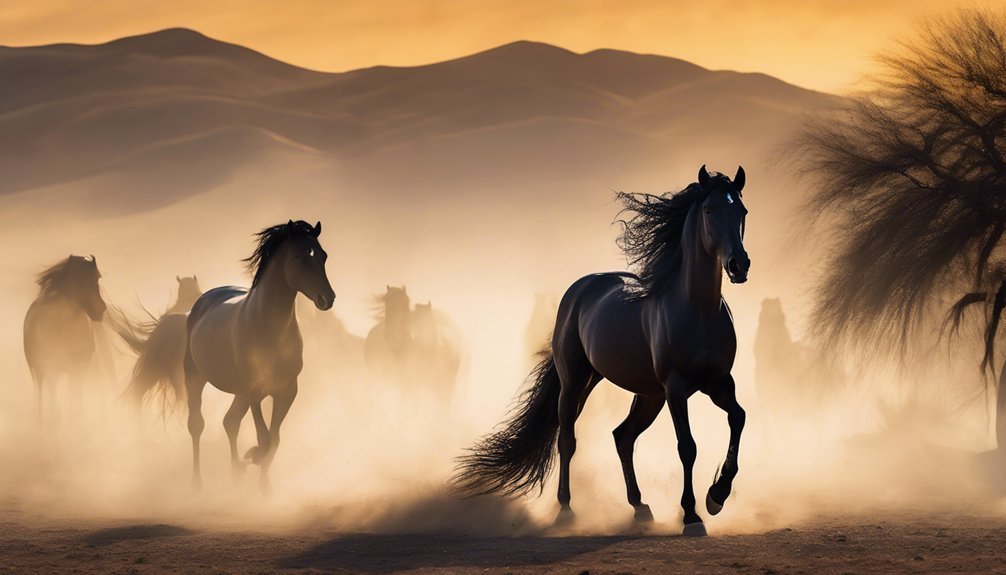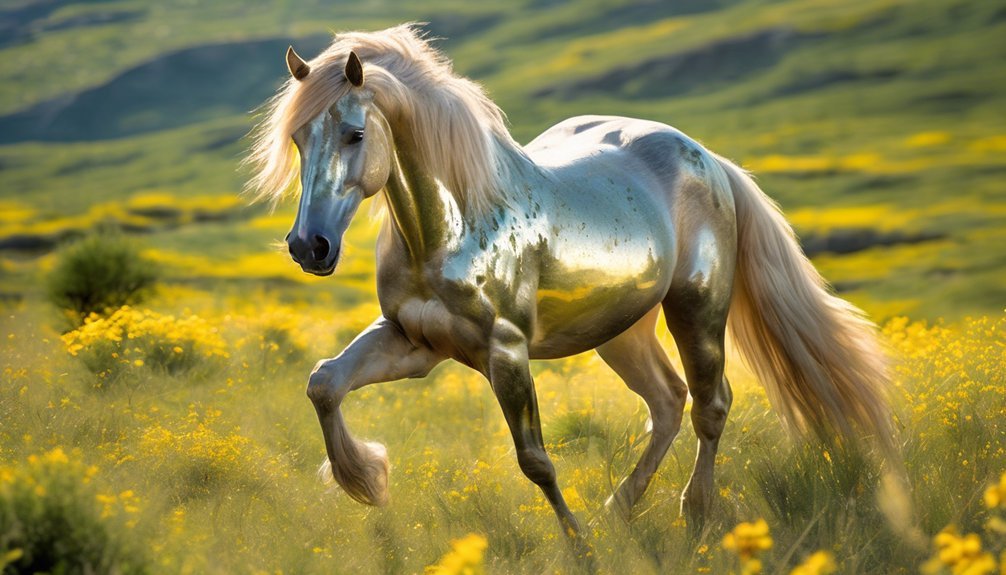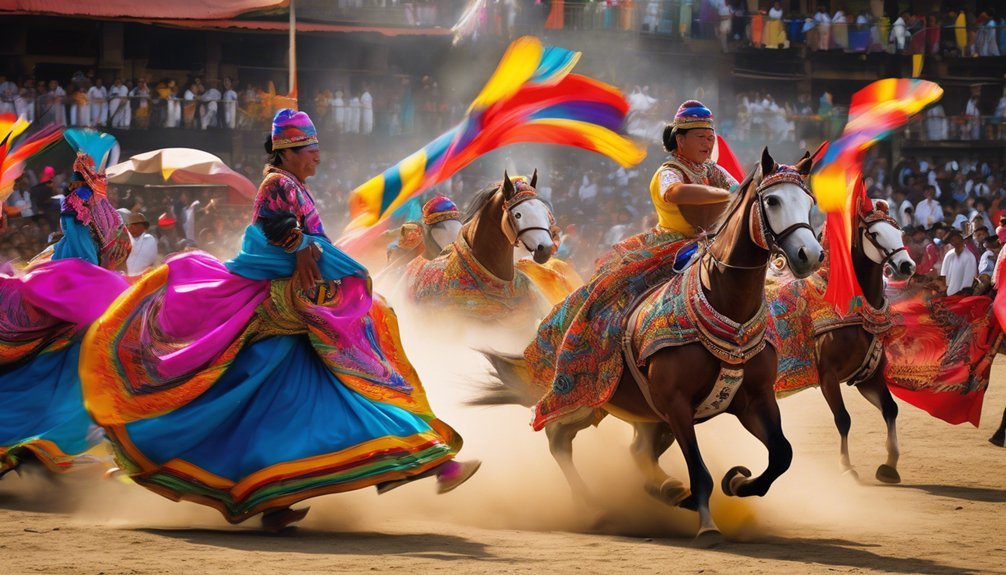
Horses have evolved remarkable adaptations to thrive in various climates around the globe. From their thick winter coats to their lean summer physiques, these animals showcase incredible resilience. You might wonder how specific breeds, like the Arabian or Fjord, have developed unique traits suited for their environments. Understanding these adaptations not only highlights their evolutionary journey but also raises questions about their future in our changing climate. What challenges will they face next?
Key Takeaways
- Horses adapt to diverse climates through physical traits, such as thicker coats in cold regions and leaner bodies in warmer areas.
- Seasonal shedding patterns help regulate body temperature, preparing horses for varying weather conditions.
- Regional breeds exhibit unique traits, like the Arabian horse's heat resistance and Fjord horses' compact bodies for cold climates.
- Horses utilize behavioral strategies, including seeking shelter, adjusting activity levels, and altering grazing habits in response to extreme weather.
- Climate change may drive genetic shifts in horse populations, impacting their adaptability to new environmental conditions.
The Evolution of Horses in Diverse Climates

As horses evolved, they adapted to various climates, showcasing remarkable resilience and versatility.
You'll appreciate how these magnificent creatures developed evolutionary traits that allow them to thrive in diverse habitats. Their ability to forage on different vegetation types reflects their adaptability, enabling them to survive in both arid and lush environments.
For instance, horses in colder regions possess thicker coats and broader hooves, while those in warmer climates have leaner bodies and shorter hair.
These adaptations aren't just physical; they also influence their social structures and behaviors. Understanding this habitat diversity deepens your connection to horses, reminding you of their extraordinary journey through time and space.
Embracing their evolutionary story invites you to appreciate their strength and grace even more.
Physiological Adaptations to Cold Environments
When temperatures drop, your horse's body gears up to survive the chill in impressive ways.
You'll notice a thick winter coat forming, which traps warmth and shields against harsh winds.
Along with this, increased body fat reserves and reduced blood flow to extremities help maintain core temperature, ensuring your horse stays healthy and comfortable in cold environments.
Thick Winter Coat
Horses face the biting chill of winter with remarkable resilience, thanks to their thick winter coat, an impressive physiological adaptation that serves as nature's insulation. This thick layer offers significant winter coat benefits, allowing your horse to thrive in frigid temperatures.
| Insulation Properties | Benefits |
|---|---|
| Traps warm air | Keeps body heat regulated |
| Water-resistant outer layer | Protects against moisture |
| Dense undercoat | Provides extra warmth |
| Shedding in spring | Prepares for warmer months |
As temperatures drop, your horse's coat grows denser and longer, enhancing its insulation properties. This adaptation not only keeps them warm but also supports their overall well-being, allowing them to face winter with strength and grace.
Body Fat Reserves
Body fat reserves play a crucial role in how equines adapt to cold environments, acting as both an energy source and a thermal insulator.
When temperatures drop, your horse's body relies on these reserves for energy storage, ensuring they've the fuel needed for essential functions. This fat not only provides energy but also helps maintain warmth, creating a protective layer against the biting chill.
As your equine friend faces harsh conditions, these survival strategies become vital. A well-nourished horse can better withstand winter's challenges, using its fat reserves wisely.
Understanding this intimate connection between your horse's health and its ability to adapt can deepen your bond, as you support them through the rigors of seasonal change.
Reduced Blood Flow
As temperatures plummet, your horse's physiological response includes reduced blood flow to extremities, a critical adaptation for conserving core body heat.
This natural mechanism helps maintain vital blood circulation to the organs that need it most, ensuring your horse stays warm and functional.
When the cold hits, the body prioritizes heat retention, diverting blood from the legs and hooves where heat dissipation is more likely.
You may notice your horse's legs feeling colder to the touch, but don't worry—this is a sign of their remarkable adaptation.
By minimizing heat loss, your horse can thrive even in frigid environments, showcasing their resilience.
Understanding these adaptations deepens your bond, allowing you to care for them more effectively during harsh weather.
Coping Mechanisms for Hot and Arid Conditions
While you might picture horses galloping through lush pastures, their survival in hot and arid climates reveals a fascinating array of adaptations.
To cope with heat stress, they often exhibit shade-seeking behaviors, instinctively moving toward trees or any cover to escape the sun's intensity.
These remarkable creatures also practice water conservation, drinking sparingly and efficiently utilizing moisture from their forage.
Their foraging strategies shift, focusing on drought-resistant plants, ensuring they get the nutrients they need without expending excessive energy.
Through these adaptive behaviors, horses demonstrate impressive desert survival skills, managing to thrive where conditions seem harsh.
Understanding these mechanisms deepens your appreciation for their resilience and grace in even the toughest environments.
The Role of Coat and Color in Temperature Regulation

When you observe a horse's coat, you might notice how its thickness and color play crucial roles in regulating temperature. A thicker coat provides insulation in cold weather, while lighter colors can reflect sunlight, helping to keep your horse cool in warmer climates.
Additionally, understanding seasonal shedding patterns can give you insights into how horses naturally adapt to changing temperatures throughout the year.
Coat Thickness Variations
Horses display remarkable adaptability in coat thickness and color, which play crucial roles in regulating their body temperature across various climates.
You'll notice that during colder months, your horse develops a thicker coat that traps air and insulates against the chill. This natural phenomenon is complemented by your efforts in coat care and seasonal grooming, ensuring their fur remains healthy and functional.
Conversely, as temperatures rise, their coat sheds, allowing for better heat dissipation. Understanding these variations helps you appreciate the relationship between your horse's coat and their comfort.
Color and Heat Absorption
The color of a horse's coat significantly influences its ability to manage temperature in different environments. Lighter coats reflect sunlight, enhancing heat resistance, while darker coats absorb more warmth, which can be beneficial in cooler climates. This color adaptation is crucial for your horse's comfort and overall health, especially as temperatures fluctuate.
| Coat Color | Heat Absorption Level |
|---|---|
| Black | High |
| Dark Bay | Medium-High |
| Chestnut | Medium |
| Gray | Low |
| Palomino | Very Low |
Seasonal Shedding Patterns
As temperatures change with the seasons, a horse's shedding patterns play a pivotal role in regulating body temperature and adapting to varying climates.
You might notice that during spring, your horse sheds its thick winter coat, making way for a lighter, airier summer coat. This seasonal shedding isn't just about aesthetics; it's essential for effective coat maintenance and comfort.
The denser winter coat traps heat, while the summer coat allows for better airflow and cooling. Additionally, color can influence how much heat a horse absorbs. Darker coats can retain warmth, while lighter coats reflect sunlight.
Behavioral Adaptations to Extreme Weather
When faced with extreme weather, horses exhibit a range of behavioral adaptations that help them cope with harsh conditions.
Their social behavior plays a crucial role; they often huddle together for warmth, enhancing herd dynamics and reducing stress responses.
You might notice changes in their grazing habits, as they seek out sheltered areas and alter foraging strategies to find food.
During intense heat or cold, horses engage in behavioral thermoregulation, adjusting their activity levels according to temperature tolerance.
Shelter seeking becomes paramount, as they instinctively look for protection from elements.
In some cases, migration patterns emerge, allowing them to move towards more favorable climates.
Water sourcing also becomes critical, as they adapt their routines to ensure hydration amidst challenges.
Hydration Strategies for Horses in Dry Climates
While navigating the challenges of dry climates, horses employ several effective hydration strategies to maintain their health and performance. They instinctively seek out hydration sources, such as troughs or natural water bodies, often drinking more frequently but in smaller amounts.
You might notice them nibbling on moist grasses or feed, which also contribute to their fluid intake. It's essential to monitor them closely, as dehydration can lead to heat stress, especially during peak temperatures.
Providing access to shade and fresh water is crucial in preventing these risks. By understanding and supporting their natural behaviors, you help ensure they stay hydrated and comfortable, allowing them to thrive even in the harshest of conditions.
Your attentive care makes all the difference.
The Impact of Humidity on Horse Health and Performance

Humidity can significantly affect a horse's health and performance, particularly in regions where the air becomes thick and oppressive. High humidity levels can lead to dehydration, making it harder for your horse to regulate body temperature and maintain energy levels.
This can negatively impact performance metrics, as your horse may struggle to perform at its best during workouts or competitions. Respiratory issues may also arise due to the damp air, complicating breathing and endurance.
You might notice your horse becoming fatigued more quickly or showing signs of stress. Understanding these humidity effects allows you to adjust training schedules, provide adequate hydration, and create a comfortable environment.
Regional Breeds and Their Climate-Specific Traits
Regional breeds of horses have evolved unique traits that enable them to thrive in their specific climates, showcasing nature's remarkable adaptability.
For instance, the Arabian horse, known for its endurance, possesses a lightweight frame and a heat-resistant coat, allowing it to excel in arid environments.
In contrast, the sturdy Fjord horse, with its thick mane and compact body, is perfectly suited for colder climates, providing warmth and strength.
These regional characteristics illustrate the rich breed diversity among horses, each adapted to their surroundings.
Understanding these traits helps you appreciate the intimate bond between horses and their environments, highlighting how these magnificent creatures have evolved to meet the challenges of their specific habitats.
The Future of Horses in Changing Environmental Conditions
As climate change continues to reshape ecosystems worldwide, the future of horses hinges on their ability to adapt to these evolving environmental conditions.
You'll notice that future adaptations may include genetic shifts, enabling them to thrive in increasingly extreme temperatures. Understanding their needs is crucial; for example, ensuring access to shade and water can enhance their climate resilience.
As their habitats change, you might witness shifts in behavior or diet, reflecting their need to cope with new challenges. By fostering a deeper connection with these majestic beings, you can support initiatives that promote their well-being and adaptability.
Together, we can create a world where horses not only survive but flourish amidst the uncertainties of a changing climate, enriching our lives in the process.
Frequently Asked Questions
How Do Horses Communicate in Different Climates?
Horses communicate through body language and vocalizations, adapting their expressions based on their environment. You'll notice how they shift their stance or change whinnies, conveying emotions and intentions uniquely in varying climates, deepening your bond.
What Are the Dietary Needs of Horses in Extreme Weather?
Did you know horses can consume 2% of their body weight in forage daily? In extreme weather, consider adjusting their forage requirements and implementing hydration strategies to keep them healthy, happy, and thriving despite the challenges.
How Does Climate Change Affect Horse Breeding Practices?
Climate change challenges your breeding techniques, pushing you to prioritize climate resilience. You'll need to select horses that thrive in varying conditions, ensuring their health and performance while adapting practices to safeguard future generations.
Can Horses Recognize Changes in Weather Patterns?
Horses can practically sense the weather like a seasoned meteorologist! They pick up on subtle weather cues and adjust their seasonal behavior, showing an incredible ability to adapt to changing conditions that affect their daily lives.
What Role Do Genetics Play in a Horse's Climate Adaptability?
Genetic variation significantly influences a horse's environmental adaptation. You'll see how certain traits enhance their resilience to climate extremes, allowing them to thrive in diverse conditions, ultimately reflecting the beautiful complexity of their genetic heritage.
Conclusion
In navigating the challenges of diverse climates, horses showcase an incredible resilience that mirrors their adaptability. They've mastered the art of survival, whether it's donning a warm winter coat or shedding their layers in the heat. As we witness the subtle shifts in our environment, it's crucial to ensure these magnificent creatures continue to thrive. By understanding their needs and unique traits, we can help safeguard their legacy, ensuring they gallop gracefully into the future.





